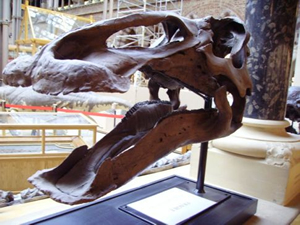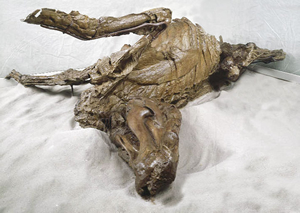Edmontosaurus regalis - Heribivore Dinosaurs
Homepage > Herbivore Dinosaurs - Edmontosaurus regalis
(ed-mon-toe-sor-uhss)
"Edmonton lizard"
Describer Lambe, 1917
Also Known As Anatosaurus Lull & Wright,
1942
Type of Species regalis
Order Ornithischia
SubOrder Ornithopoda
InfraOrder --
Micro-Order --
SuperFamily --
Family Hadrosauridae
SubFamily Hadrosaurinae
Size 40 feet (12.2 meters) long
Period Late Cretaceous, 65 million years ago
Fossilsite Colorado, North Dakota, South Dakota, Wyoming,
Montana, Alaska, USA; Alberta, Canada
Diet Herbivore
 Edmontosaurus
lived during the Late Cretaceous Period about 70 million years ago, in
what is now Alberta, Canada. The hadrosaurids, or duck-billed dinosaurs,
were a family of large ornithopods, which are informally named after the
wide, flattened front part of their mouths. This was covered in a horny,
toothless beak and looked like the bill of a monstrous duck. Edmontosaurus
would have used this beak to bite of plant matter, which it chewed with
the many tightly packed battery of teeth at the back of both jaws. As
teeth wore out, they were replaced with new ones.
Edmontosaurus
lived during the Late Cretaceous Period about 70 million years ago, in
what is now Alberta, Canada. The hadrosaurids, or duck-billed dinosaurs,
were a family of large ornithopods, which are informally named after the
wide, flattened front part of their mouths. This was covered in a horny,
toothless beak and looked like the bill of a monstrous duck. Edmontosaurus
would have used this beak to bite of plant matter, which it chewed with
the many tightly packed battery of teeth at the back of both jaws. As
teeth wore out, they were replaced with new ones.
Edmontosaurus was one of the last hadosaurids, and also one of the largest. It is presumed that Edmontosaurus grew to weigh as much as 5 tons. It possessed powerful front legs and hooves on its "hands". As well, its spine was supported by huge bony tendons, which crisscrossed all the way down.
Some fossil finds of this dinosaur have preserved impressions of the skin around part of the body, including the "hand". It was one of these "mummified" fossils that lead to the reconstruction of hadrosaurids as mainly aquatic animals. The skin of Edmontosaurus's hand shows a structure between the fingers that looks like the webbed foot of a duck. It was realized later that the believed webbing was actually padding behind the hooves. Modern reconstructions of Edmontosaurus and other hadosaurids show them as fully terrestrial animals.
